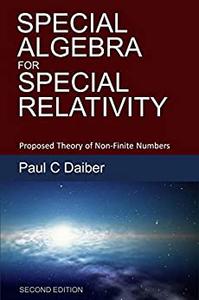
没有正实无穷大的应用数学代数——麦克斯韦方程组与狄拉克方程相结合,将电子动力学与光子动力学结合起来,因为通过使用代数,电子将自身投影为光子。电子/光子双重存在源于薛定谔的猫,因为超过有限最大计数的实数的每个位值数字都是未知和不可知的,类似于猫在其未打开的盒子中既活又死。代数是从一个提出的公理中推导出来的,该公理取代了康托的连续统假设。-经验推导的能量密度和波因廷矢量在力密度不变量中统一为一个数学模型。这种统一性表明,我们几何世界中的量实际上具有有限的不精确性,而且新代数适用于更现代的物理理论。-可视化和练习有助于理解数学非常简单,一名高中生可以理解,他参加了大学一年级的数学和物理课程(并且熟悉三角学和对数、复数、矩阵乘法、几何单位向量和偏微分方程)。-两个地方的一个粒子违反了一个先入为主的观念,即这是不可能的。一个粒子是物质(费米子电子),另一个粒子是力(玻色子光子)。把这个激进的概念进一步假设为,感知到的现实来自数字,单独来自物体,通过相互之间变得更加精确而相互作用,形成我们所看到的狄拉克方程和其他物理数学模型的模式。宇宙基本上是数字。-前言——狭义相对论的狭义代数前四章介绍了狭义相对论的全数数学结构。第五章通过将位值数字限制为小数点前后的最大计数,将可测量量限制为有限精度。-例如,一个单位正方形的每一侧都增加了小幅度的有限不精确性。有限不精确加法器是一种非有限类型的数,因为它是不可知的。-大于可测量量的有限不精确是小幅度不精确的除法倒数。在狭义相对论中,使用洛伦兹变换,时空双曲线角“alpha”(与速度相关的“v=c*tanh(alpha)”)增加了大幅度的不精确性。将麦克斯韦方程组和狄拉克方程组结合起来,建立了大型不精确电磁模型。精度随着时间的推移而提高,从而产生可测量的动态。-电磁场力密度分量的计算过程与电流密度分量的计算过程相同。包括能量密度和波因廷矢量分量。-将这三种经验推导出的电磁现象合并到一个数学模型中是新的,成功表明,我们几何世界中的量实际上具有有限的不精确性,并表明有限的不精确数也应该适用于更现代的物理理论。
Special Algebra for Special Relativity: Second Edition: Proposed Theory of Non-Finite Numbers
Applied mathematics algebra without positive actual infinity – Maxwell’s Equations unite with the Dirac Equation to combine electron dynamics with photon dynamics because, by use of the algebra, an electron projects itself as a photon. Electron/photon double existence derives from Schrцdinger’s Cat because each place-value digit of a real number beyond a finite maximum in count is unknown and unknowable, analogous to the cat being both alive and dead inside its unopened box. The algebra is derived from a proposed axiom that replaces Cantor’s Continuum Hypothesis. – Empirically derived energy density and the Poynting Vector unite in the force density invariant as one mathematical model. That unity suggests quantities in our geometric world actually do have finite imprecision, and that the new algebra applies to more modern theories of physics. – Visualizations and exercises help comprehension. – The mathematics is simple enough to be understood by a high school student who has taken first year level college math and physics classes (and is familiar with trigonometry and logarithms, complex numbers, matrix multiplication, geometric-unit-vectors, and partial differential equations). – One particle at two places violates a preconceived notion that that isn’t possible. The one particle is material (fermion electron) and, its opposite, force (boson photon). Take this radical notion further by supposing perceived reality results from numbers, alone from objects, interacting by becoming more precise with respect to each other, to form patterns we see as the Dirac Equation and other mathematical models of physics. The universe is fundamentally numbers. – Preface – The first four chapters of Special Algebra for Special Relativity present an all-number mathematical structure for Special Relativity. The fifth chapter restricts a measurable quantity to finite precision by limiting place-value digits to a maximum count before and after the decimal point. – For example, each side of a unit square has small magnitude finite imprecision added to it. The finite imprecision adder is a non-finite type of number because it isn’t knowable. – Finite imprecision larger than a measurable quantity is the division reciprocal of small magnitude imprecision. In Special Relativity large magnitude imprecision is added to time-space hyperbolic angle “alpha” (that relates to speed by “v = c*tanh(alpha)”) using a Lorentz Transformation. Large magnitude imprecision models electromagnetism by uniting Maxwell’s Equations with the Dirac Equation. Precision improves with time to cause measurable dynamics. – Electromagnetic field force density components are calculated using the same process by which electric current density components are calculated. Included are energy density and Poynting Vector components. – Uniting those three empirically derived electromagnetic phenomena into one mathematical model is new and that success suggests quantities in our geometric world actually do have finite imprecision and suggests finite imprecision numbers should also apply to more modern theories of physics.
OR




